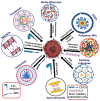Modernistic and Emerging Developments of Nanotechnology in Glioblastoma-Targeted Theranostic Applications
- PMID: 35163563
- PMCID: PMC8836088
- DOI: 10.3390/ijms23031641
Modernistic and Emerging Developments of Nanotechnology in Glioblastoma-Targeted Theranostic Applications
Abstract
Brain tumors such as glioblastoma are typically associated with an unstoppable cell proliferation with aggressive infiltration behavior and a shortened life span. Though treatment options such as chemotherapy and radiotherapy are available in combating glioblastoma, satisfactory therapeutics are still not available due to the high impermeability of the blood-brain barrier. To address these concerns, recently, multifarious theranostics based on nanotechnology have been developed, which can deal with diagnosis and therapy together. The multifunctional nanomaterials find a strategic path against glioblastoma by adjoining novel thermal and magnetic therapy approaches. Their convenient combination of specific features such as real-time tracking, in-depth tissue penetration, drug-loading capacity, and contrasting performance is of great demand in the clinical investigation of glioblastoma. The potential benefits of nanomaterials including specificity, surface tunability, biodegradability, non-toxicity, ligand functionalization, and near-infrared (NIR) and photoacoustic (PA) imaging are sufficient in developing effective theranostics. This review discusses the recent developments in nanotechnology toward the diagnosis, drug delivery, and therapy regarding glioblastoma.
Keywords: blood–brain barrier; glioblastoma; nanotechnology; theranostics.
Conflict of interest statement
The authors declare no conflict of interest.
Figures




Similar articles
-
Modern insights of nanotheranostics in the glioblastoma: An updated review.Biochim Biophys Acta Mol Basis Dis. 2025 Mar;1871(3):167653. doi: 10.1016/j.bbadis.2024.167653. Epub 2025 Jan 3. Biochim Biophys Acta Mol Basis Dis. 2025. PMID: 39756713 Review.
-
Emerging blood-brain-barrier-crossing nanotechnology for brain cancer theranostics.Chem Soc Rev. 2019 Jun 4;48(11):2967-3014. doi: 10.1039/c8cs00805a. Chem Soc Rev. 2019. PMID: 31089607 Review.
-
Immunoengineering in glioblastoma imaging and therapy.Wiley Interdiscip Rev Nanomed Nanobiotechnol. 2019 Nov;11(6):e1575. doi: 10.1002/wnan.1575. Epub 2019 Aug 12. Wiley Interdiscip Rev Nanomed Nanobiotechnol. 2019. PMID: 31407522 Review.
-
Nanoparticles Mediated the Diagnosis and Therapy of Glioblastoma: Bypass or Cross the Blood-Brain Barrier.Small. 2023 Nov;19(45):e2302613. doi: 10.1002/smll.202302613. Epub 2023 Jul 7. Small. 2023. PMID: 37415556 Review.
-
Magnetic Resonance Nano-Theranostics for Glioblastoma Multiforme.Curr Pharm Des. 2015;21(36):5256-66. doi: 10.2174/1381612821666150923103307. Curr Pharm Des. 2015. PMID: 26412354 Review.
Cited by
-
The Confluence of Nanotechnology and Heat Shock Protein 70 in Pioneering Glioblastoma Multiforme Therapy: Forging Pathways Towards Precision Targeting and Transformation.Adv Pharmacol Pharm Sci. 2025 Apr 24;2025:1847197. doi: 10.1155/adpp/1847197. eCollection 2025. Adv Pharmacol Pharm Sci. 2025. PMID: 40313865 Free PMC article. Review.
-
Single-cell and spatial atlas of glioblastoma heterogeneity: characterizing the PCLAF+ subtype and YEATS4's oncogenic role.Front Immunol. 2025 Jul 25;16:1614549. doi: 10.3389/fimmu.2025.1614549. eCollection 2025. Front Immunol. 2025. PMID: 40787449 Free PMC article.
-
Nanotherapy of Glioblastoma-Where Hope Grows.Int J Mol Sci. 2025 Feb 20;26(5):1814. doi: 10.3390/ijms26051814. Int J Mol Sci. 2025. PMID: 40076445 Free PMC article. Review.
-
Nanoparticles for Glioblastoma Treatment.Pharmaceutics. 2025 May 23;17(6):688. doi: 10.3390/pharmaceutics17060688. Pharmaceutics. 2025. PMID: 40574001 Free PMC article. Review.
-
Nanomaterials in Cancer Diagnosis and Therapy.Int J Mol Sci. 2022 Nov 9;23(22):13770. doi: 10.3390/ijms232213770. Int J Mol Sci. 2022. PMID: 36430246 Free PMC article.
References
-
- Ruan S.B., Qin L., Xiao W., Hu C., Zhou Y., Wang R.R., Sun X., Yu W.Q., He Q., Gao H.L. Acid-responsive transferrin dissociation and glut mediated exocytosis for increased blood-brain barrier transcytosis and programmed glioma targeting delivery. Adv. Funct. Mater. 2018;28:1802227. doi: 10.1002/adfm.201802227. - DOI
Publication types
MeSH terms
Grants and funding
LinkOut - more resources
Full Text Sources
Medical
Miscellaneous

